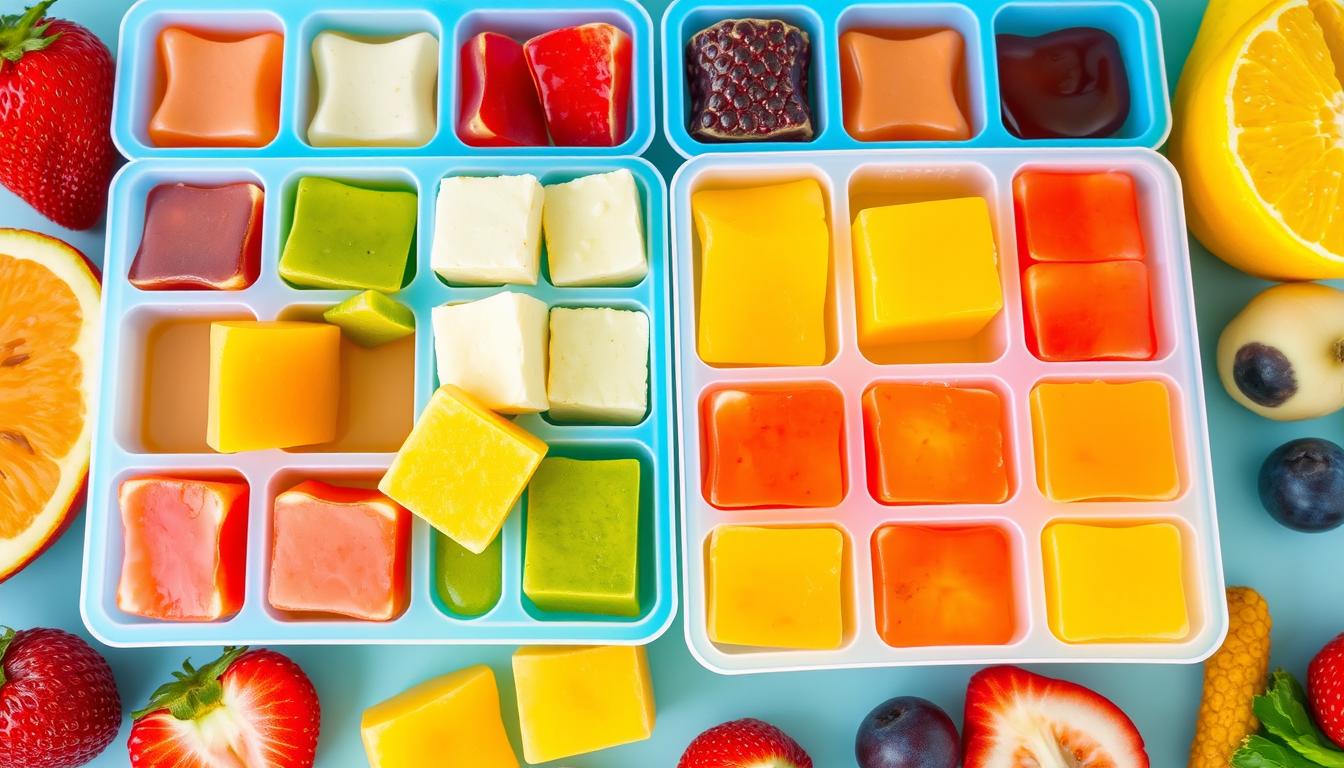As a parent, your top priority is ensuring the best for your little one. Choosing the right baby food can be tough. But, frozen baby food makes it easier to give your child the nutrition they need.
Parenthood is full of joys and challenges. Feeding your child should give you peace of mind. Frozen baby food is a convenient solution, with many flavors and textures your baby will enjoy.
Having healthy meals ready can be a big help for busy parents. The frozen baby food market has everything from organic purees to finger foods. It caters to your child’s changing tastes and nutritional needs.
Table of Contents
Understanding the Rise of Frozen Baby Food
It has gained significant popularity in recent years, offering parents a convenient and nutritious option. They prefer it over traditional jarred foods because of its better ingredients and processing.
Benefits of Choosing Frozen Over Traditional Options
It has many advantages. It lasts longer than fresh or refrigerated options. You can store it for up to 3 months, which helps reduce food waste.
Nutritional Value Retention in Frozen Foods
Frozen baby food is often thought to be less nutritious. But, the truth is, it can keep more nutrients than traditional foods. The flash-freezing method helps preserve vitamins and minerals, giving your baby the nutrients they need.
Cost-Effectiveness for Parents
Frozen organic toddler food is also a budget-friendly choice. Buying in bulk and using its long shelf life can save money. It’s great for parents who want to give their kids healthy meals without breaking the bank.
“Frozen baby food provides a practical and nutritious solution for busy parents striving to give their little ones the best start in life.”
Top Brands in the Frozen Baby Food Market
The market is booming, giving parents lots of choices. Nurture Life, Little Spoon, and others are leading the way.
Nurture Life is known for its high-quality ingredients and meal planning. Their meals are organic, non-GMO, and free from harmful additives. Parents love that Nurture Life focuses on balanced nutrition for their kids.
Little Spoon uses Tiny’s Organic ingredients in its Pure Bambinos line. They provide an extensive selection of meals for breakfast, lunch, and dinner, catering to the diverse tastes and nutritional needs of babies and toddlers.
| Brand | Ingredient Sourcing | Product Range | Key Highlights |
|---|---|---|---|
| Nurture Life | Organic, Non-GMO | Breakfast, Lunch, Dinner | Age-appropriate meals, Balanced nutrition |
| Little Spoon | Tiny’s Organic Ingredients | Pure Bambinos Line | Diverse menu, Caters to dietary needs |
These brands stand out in the frozen baby food market. They offer unique benefits to parents looking for healthy, easy-to-prepare meals for their bambino babies. As demand grows, so will the competition, benefiting both babies and their families.
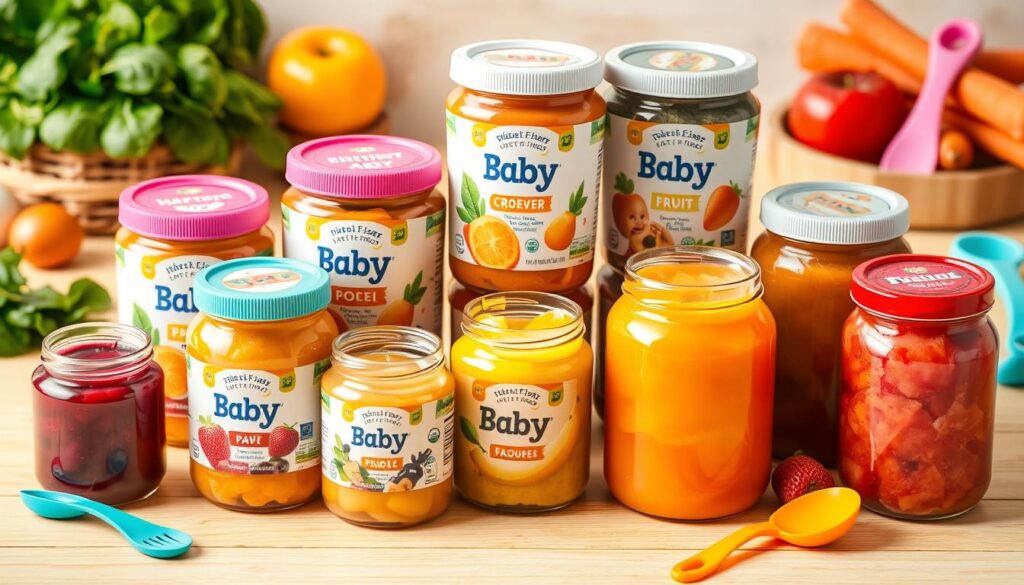
Nurture Life vs Little Spoon: A Comparative Look
Parents looking for the best frozen baby food often consider Nurture Life and Little Spoon. We’ll compare their prices, menu options, and delivery services. This will help you choose the best for your baby.
Pricing Structure Analysis
Little Spoon charges $2.82 per meal item. Nurture Life’s prices are not listed here, but they offer various options for different budgets.
Menu Variety and Options
Little Spoon has 111 meal choices each week. Nurture Life offers 4 types of products. But Nurture Life’s menu goes from 10-month-old babies to school kids, covering all ages.
Delivery and Subscription Features
Nurture Life is better at ordering and delivery, the text says. They also let parents customize meals for their child’s needs.
| Feature | Nurture Life | Little Spoon |
|---|---|---|
| Pricing per Meal | Not Disclosed | $2.82 |
| Menu Variety | 4 Product Types | 111 Choices per Week |
| Delivery and Subscription | Efficient and Reliable | Not Specified |
| Customization Options | 11 Dietary Options | Not Specified |
Nurture Life seems to be the better choice. They offer great nutrition, a wide menu, and easy delivery. This makes them a top pick for the best toddler meal subscription and baby food delivery.
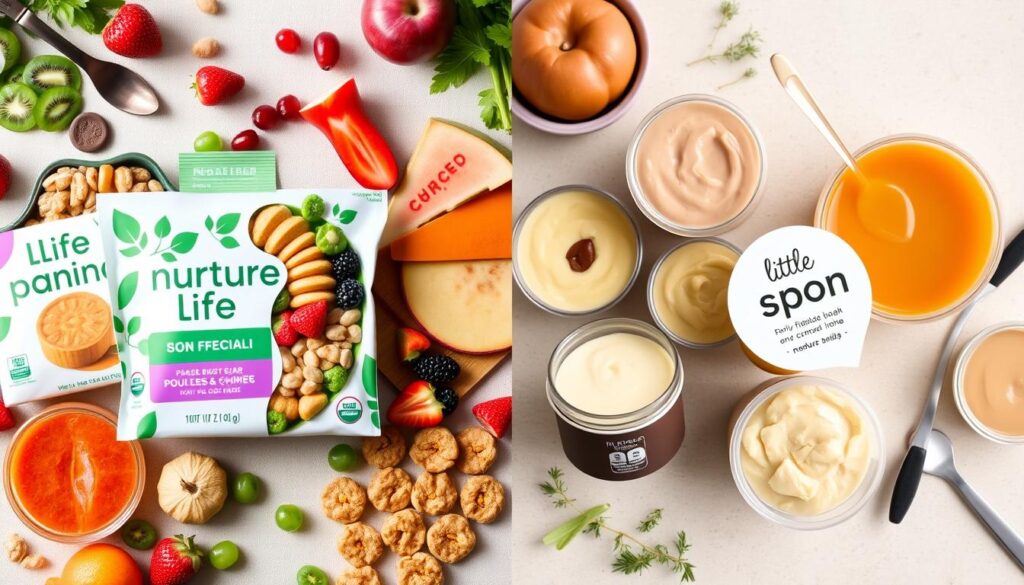
How to Store and Handle Frozen Baby Food
Storing and handling frozen baby food right is key for your baby’s health and nutrition. Keep these essential tips in mind:
Refrigeration Times for Opened Baby Food: After opening, homemade or store-bought baby food stays good in the fridge for up to 2 days. If it’s defrosted, use it within 24 hours. Always remember that leftover baby food containing rice or formula milk should be consumed within 1 day.
Freezer Storage Tips: Frozen baby food can be safely stored for up to 3 months in a freezer maintained at 0°F (-18°C) or lower. You can freeze portions made with frozen ingredients before. But, don’t refreeze food that’s thawed without cooking it first.
| Storage Guideline | Timeframe |
|---|---|
| Refrigerator (opened baby food) | Up to 2 days |
| Refrigerator (defrosted baby food) | Up to 24 hours |
| Freezer (frozen baby food) | Up to 3 months |
Homemade Baby Food Storage: For homemade baby food in the freezer, use airtight containers or ice cube trays. This helps maintain freshness and prevents freezer burn. Always label each portion with the date and what’s inside for easy tracking.
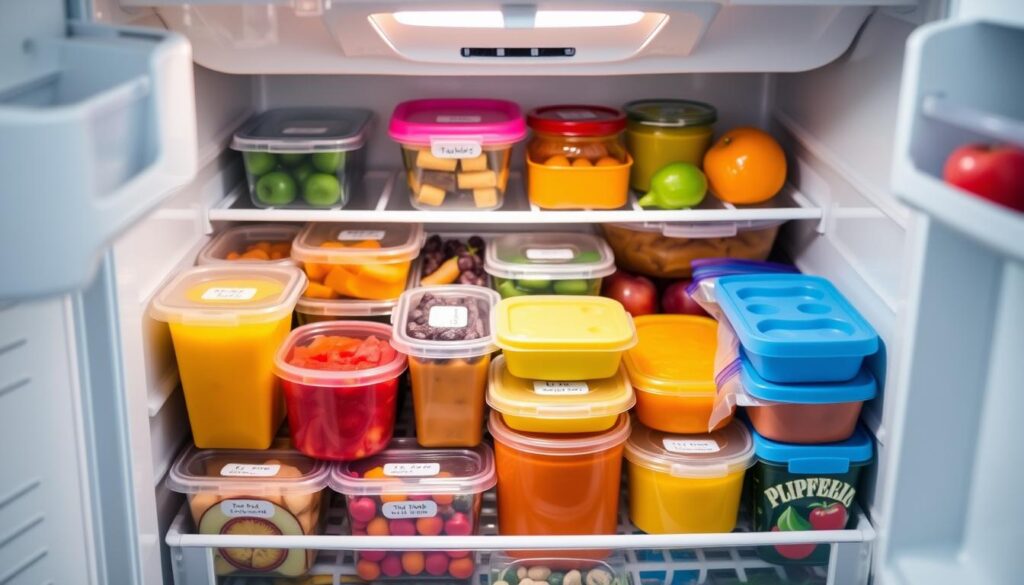
By sticking to these easy storage tips, you can make sure your baby gets the best nutrition and safety from frozen baby food, whether it’s store-bought or homemade.
Organic vs Non-Organic Frozen Baby Food Options
Choosing between organic and non-organic frozen baby food is a big decision for parents. It’s important to know the differences in ingredients, how they’re certified, and the cost. This helps you pick what’s best for your family’s health and budget.
Understanding Organic Certification
Organic certification means the food is made without harmful chemicals. This ensures your baby eats natural, healthy ingredients. But, it often costs more.
Price Comparison and Value Assessment
Organic baby food is pricier than non-organic. But, non-organic might have lower quality ingredients and harm the environment. Make Me Organics aims to offer organic options that are affordable and nutritious.
Choosing between organic and non-organic depends on what you value most. Knowing about certifications and comparing costs helps you decide what’s best for your baby and your family.
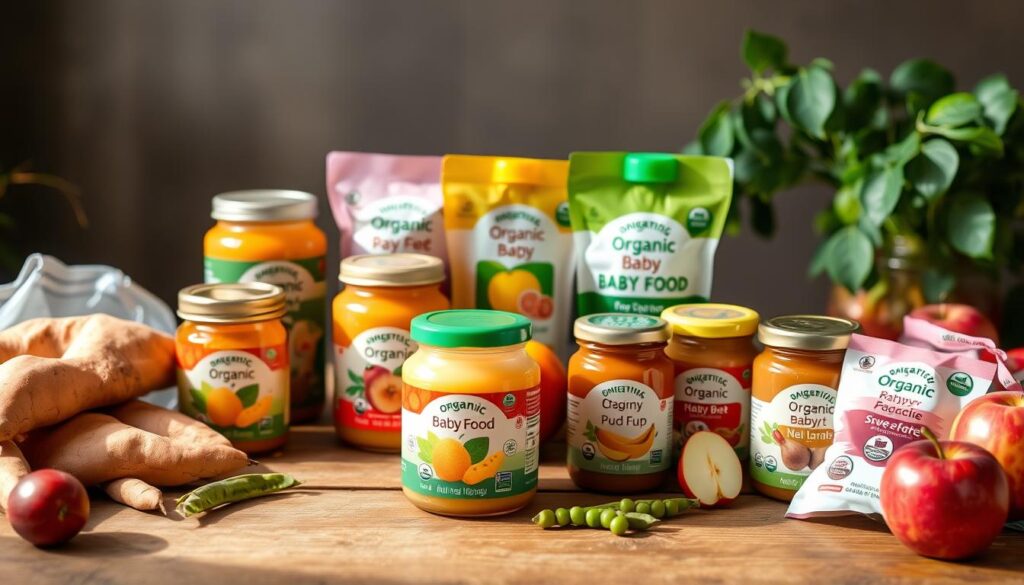
| Attribute | Organic Frozen Food | Non-Organic Frozen Food |
|---|---|---|
| Ingredients | Grown without synthetic pesticides, fertilizers, or GMOs | May contain synthetic additives and preservatives |
| Certification | Strict USDA organic certification process | No organic certification required |
| Price | Generally higher due to organic farming practices | Typically more affordable |
| Environmental Impact | Reduces exposure to harmful chemicals and promotes sustainable agriculture | May contribute to environmental pollution and depletion of natural resources |
Age-Appropriate Frozen Baby Food Stages
Exploring frozen food is exciting, knowing it matches your baby’s growth. Whether you’re new or experienced, picking the right frozen food is key. It ensures your baby gets the nutrients they need.
Frozen Baby Food for 6-9 Months
At 6-9 months, babies start with simple foods. They need purees of fruits, veggies, and proteins like chicken. These are easy to digest and rich in iron.
Frozen Baby Food for 9-12 Months
By 9-12 months, babies want more flavors and textures. Now, they can try combination purees and mashed foods. Even small diced pieces are okay for them.
Frozen Baby Food for Toddlers
Toddlers can handle more adventurous foods. Look for frozen meals and finger foods with veggies, proteins, and grains. These help with chewing and self-feeding.
Always watch over mealtime and cut food right. Avoid choking hazards. The right frozen food at each stage helps your baby grow strong.
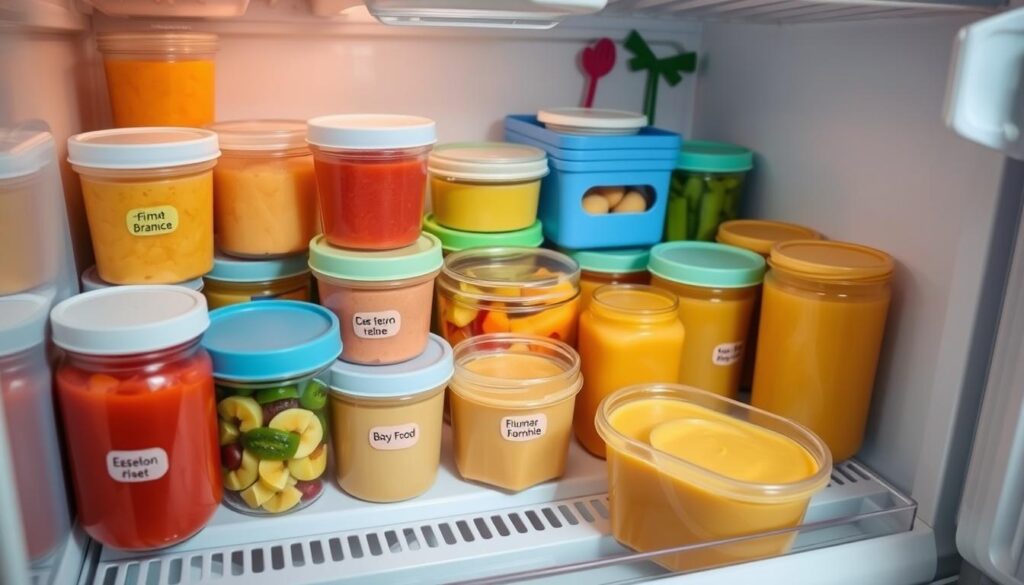
“Frozen baby food is a big help for busy parents. It’s nutritious and meets your child’s changing needs. With the right choices, your baby starts healthy eating early.”
Essential Storage Guidelines for Frozen Baby Food
Keeping your baby’s frozen food fresh and nutritious is important. Follow these tips to make sure your baby gets the best frozen meals.
Proper Freezing Techniques
To how to freeze baby food right, use airtight containers or freezer-safe bags. Make sure there’s room for the food to expand. Freezing in small portions is easier to thaw as needed. Always label each container with what’s inside and when you froze it.
The rule for how long can you freeze baby food is up to 3 months for purees and 6 months for solids. This keeps the food fresh and full of nutrients.
Thawing Methods and Safety
To how to defrost baby food safely, put it in the fridge to thaw overnight. Don’t leave it out at room temperature, as bacteria can grow. Use thawed food within 24-48 hours and never refreeze it.
If you need to thaw it fast, place the sealed container in cool water. Replace the water every 30 minutes until the food is fully thawed. Microwaving is not safe, as it can create hot spots that are harmful.
“Proper storage of frozen baby food is essential for preserving its nutrition and ensuring safety. Following these tips ensures your baby gets tasty, healthy meals.”
Success comes from focusing on freezing, storage times, and thawing safely. This way, you can give your baby the best frozen meals.
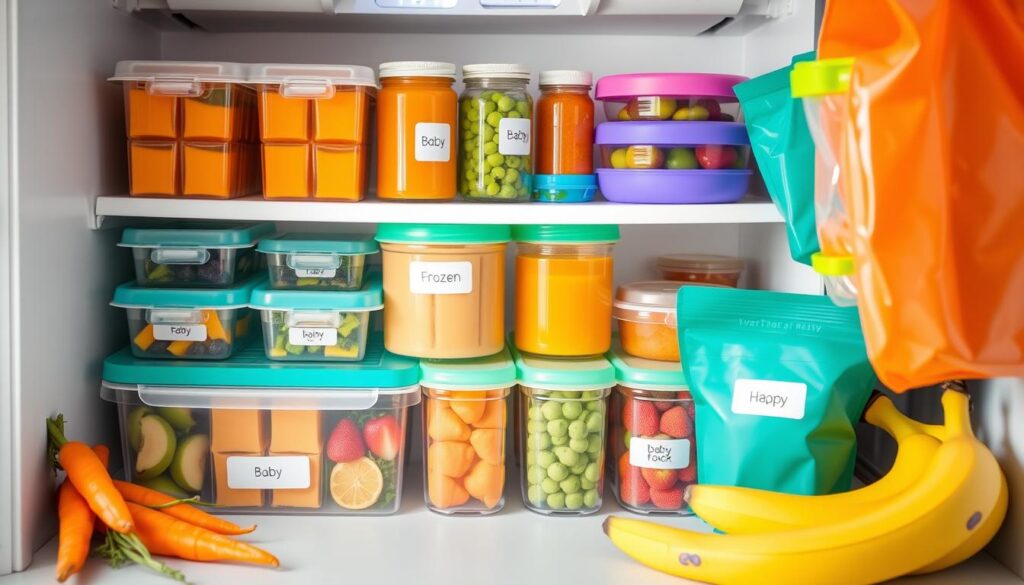
Best Practices for Preparing Frozen Baby Food
Safety and convenience are key when serving frozen baby food. Make sure you know how to thaw and heat it properly. Yes, babies can eat cold baby food, but warming it a bit is usually best.
To thaw frozen baby food safely, put the needed portion in the fridge overnight. Or, thaw it in a bowl of warm water, but keep the water away from the top. After thawing, warm the food in a microwave-safe dish in short bursts. Stir often to heat it evenly.
As your baby gets older, frozen food can introduce new textures and tastes. Just mash, cut, or break the frozen food into small pieces. This makes it easy for your baby to pick up and helps them learn to feed themselves.
FAQ
How long is baby food good for in the fridge?
How long is homemade baby food good for?
What are the benefits of choosing frozen over traditional baby food options?
How do the top frozen baby food brands compare in terms of pricing, menu variety, and delivery options?
How should I store and handle frozen baby food to ensure quality and safety?
What are the key differences between organic and non-organic frozen baby food options?
How can I ensure I’m choosing the right frozen baby food for my child’s age and stage?
How can I safely freeze and thaw homemade baby food?
How should I prepare and serve frozen baby food to ensure optimal safety and nutrition?
Source Links
- Your Questions Answered
- How to keep breast milk frozen while traveling?
- Baby Food Autism Lawsuits: Updates and Settlements (December 2024)
- Homemade Game Meat Baby Food: Nutrient-Rich Recipes for Adventurous Parents
- Baby Food Market Size, Share, Growth, Trends, Scope & Forecast
- Little Bellies Expands in Canada
- How to Choose Between Nurture Life and Little Spoon
- How to Sign Up (Only 5 Simple Steps)
- Nutrition Archives – Feeding Matters
- The Ultimate Guide to Making Stage 1 Baby Food at Home
- Heavy Metals in Baby Food: What You Need to Know
- Sweet Deception: Are Baby Foods Nutritious?
- How to Identify and Prevent Choking Hazards for Babies and Children
- Baby meal prep
- Chicken for Babies: A Complete Guide With Recipes + Baby-Led Weaning
- Emergency Food Safety
- Timely Hints On Food Storage For Food Safety Certification
- How to Feed a Baby During Travel (Nursing, Bottles, Formula & Solids)
- Can you freeze breast milk?
- Homemade Veggie Nuggets (3 Veggies + Freezer-Friendly!)
